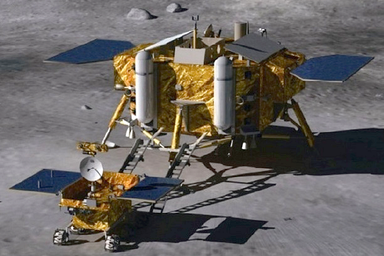While several private American companies are planning robotic missions to the moon, China launched a man-sized robotic scout to the moon on Monday. The country’s recent manned missions and efforts to build a new space base suggest a future manned mission to the moon, though why is an open question. Speculation has run from the desire to build a military missile base -- a Death Star of sorts -- to national pride to simple economics.One small step for Man at a time.... this isn't a one-time stunt, it's a slow and methodical long-term exploration and colonisation effort.
The answer may be far simpler: The moon is “easy” to get to.
“If you’re still trying to test out your space legs, it’s a great place to do it,” said one NASA engineer familiar with the agency’s plans.
Dennis Wingo, a space entrepreneur and author of the book “MoonRush,” thinks the Chinese mission is about supporting the world’s exploding population.
“China is spending billions on resource acquisition in Africa, South America and other places around the world,” he told FoxNews.com. “If you look at the design of their system for this mission, it is very much a mineral prospector as much as a science mission.”
Yet America will not return to the moon, NASA administrator Charlie Bolden makes clear.
“NASA is not going to the moon with a human as a primary project probably in my lifetime,” Bolden said at an April panel in Washington.
China’s Chang’e 3 lander -- which should touch down on the moon in mid-December -- will be the first controlled landing since the Soviet Union’s Luna-24 mission in 1976.
From Universe Today:
China’s maiden moon landing probe successfully entered lunar orbit on Friday, Dec. 6, following Sunday’s (Dec. 1) spectacular blastoff – setting the stage for the historic touchdown attempt in mid December.Previous posts on this blog have followed China's careful, methodical, and above all, successful space colonisation effort for many years. Starting in July 2003.
Engineer’s at the Beijing Aerospace Control Center (BACC) commanded the Chang’e 3 lunar probe to fire its braking thrusters for 361 seconds, according to China’s Xinhua news agency.
The do or die orbital insertion maneuver proceeded precisely as planned at the conclusion of a four and a half day voyage to Earth’s nearest neighbor.
...
Chang’e 3 is due to make a powered descent to the Moon’s surface on Dec. 14, firing the landing thrusters at an altitude of 15 km (9 mi) for a soft landing in a preselected area called the Bay of Rainbows or Sinus Iridum region.
...
Chang’e 3 marks the beginning of the second phase of China’s lunar robotic exploration program. The lander follows a pair of highly successful lunar orbiters named Chang’e 1 and 2 which launched in 2007 and 2010. The next step will be an unmanned lunar sample return mission, perhaps by 2020.
The Chinese Manned Space programme has proceeded slowly, carefully, one step at a time. And it has proceeded very successfully so far as the result.
As was written in September 2003:
Meanwhile, space officials said China hoped to launch a space probe capable of orbiting the moon by 2005 or 2006, which would be the nation's first lunar mission and would eventually lead to an eventual landing on the moon by an unmanned Chinese lunar space craft.And in October 2003 :
Yes, they've been methodical. This is not some flash-in-the-pan Space Spectacular for no more worthy a goal than National prestige. It's not a Space Race as such - because a Race implies that they're competing against some other entity. No, after consulting my Crystal Ball, taking the auguries, and examining the entrails of a goat, I think they're in it for the long term. I'm not talking about Scientific missions to Mars, or even Exploratory missions to the Moon. I'm talking about setting up a permanent presence. Not next year. Not next decade, nor the one after that. But certainly within the next 50 years. I think that they have a plan. A flexible one, that will adapt to changing circumstances and unforeseeable problems, but a plan nonetheless.Looks like phase 2 and 3 have been collapsed into one, a bit later than 2010, but earlier than 2020.There was no funding for lunar projects in the ten-year space plan approved in 2001. By July 2001 a Chinese aerospace magazine indicated that Chinese scientists had drafted a much more modest four-phase long term plan.It would surprise me if the schedule didn't slip. But no matter, there's no hurry.
Phase 1, by 2005: Lunar flyby or orbiting satellite missions, perhaps using the DFH-3 bus.
Phase 2, by 2010: unmanned soft-landing missions.
Phase 3, by 2020: Robotic exploration using surface rovers.
Phase 4, by 2030: Lunar sample return missions.
Only after 2030 would manned flights and construction of a lunar base begin.
The Shenzhou manned spacecraft provides the Chinese with the required hardware to pursue a lunar program whenever they make the decision to go.


No comments:
Post a Comment